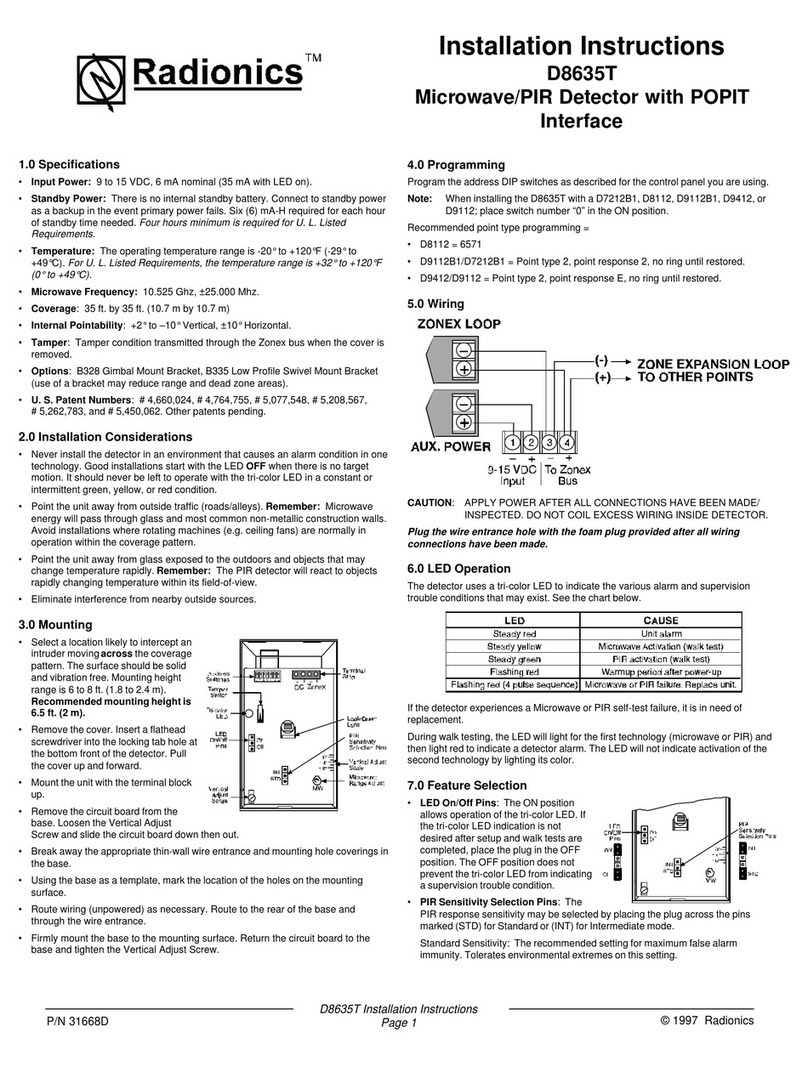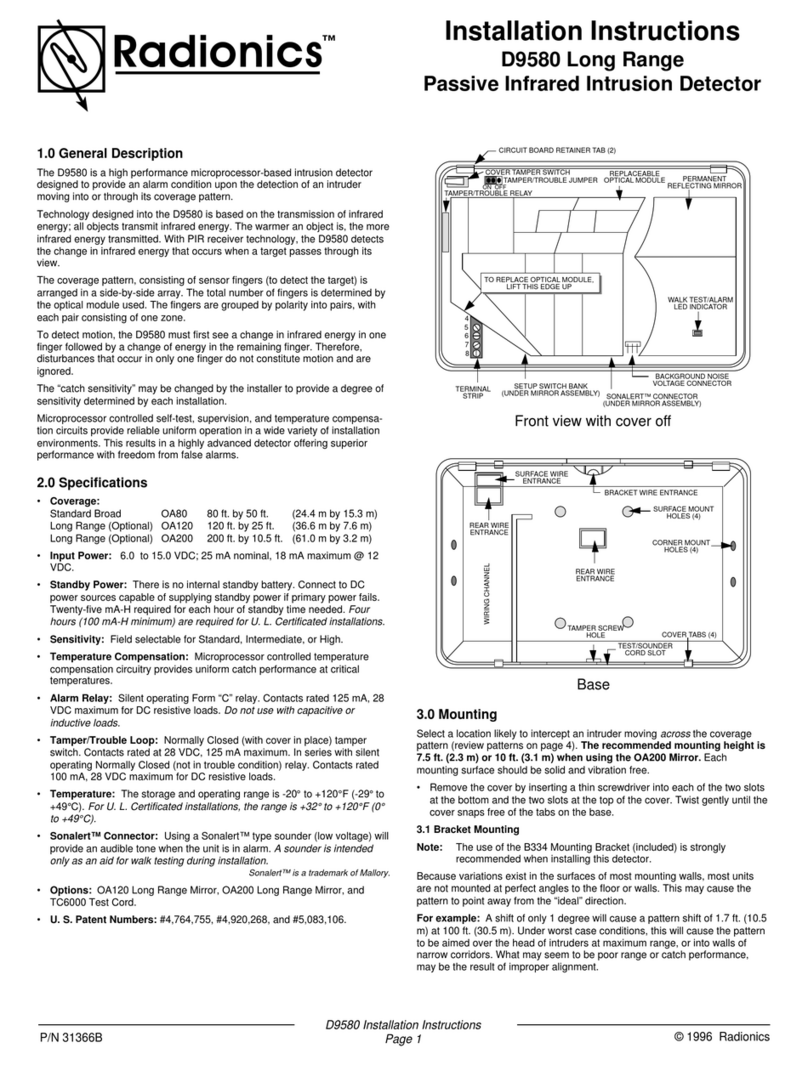
Radionics™
© 1996 Radionics, Inc., Salinas, CA, U.S.A. All rights reserved.
™ The Radionics logo is a registered trademark of Radionics, Inc., Salinas, CA, U.S.A.
Radionics, Inc., 1800 Abbott Street
Salinas, CA, 93901, U.S.A.
Customer Service: (800) 538-5807
Terminal Descriptions
•1 (–) & 2 (+): Input power. Use no smaller than #22 AWG (0.8
mm) wire pair between the detector and the power source.
•3 (NO), 4 (C), & 5 (NC): Alarm relay (reed) contacts rated at 3
Watts, 125 mA, 28 VDC maximum for DC resistive loads and
protected by a 4.7 ohm resistor in the common “C” leg of the relay.
Do not use with capacitive or inductive loads.
•6 & 7: Tamper Contact, rated 3 watts, 28 VDC, 125 mA.
Note:If using the large knockout, be sure to seal the wire
entrance with the foam plug provided. The small round
knockouts do not require the foam plug.
Note:Do not coil excess wiring inside the detector.
4.0 Configuration
Switches
The configuration switches are
described as follows:
•LED Operation:
-ON: Allows the LED to
operate when activated
by alarm.
-OFF: The LED will not operate on alarm.
•Sensitivity Mode:
- Standard: The recommended setting for maximum false alarm
immunity. Tolerates environmental extremes on this setting.
Standard Sensitivity is not recommended for Long Range or
Barrier type patterns. The detector is shipped in Standard
Sensitivity mode.
-Intermediate: The recommended setting for any location where
an intruder is expected to cover only a small portion of the
protected area. Tolerates normal environments on this setting.
This setting will improve your intruder catch performance.
-High: The recommended setting for fast response to intruder
signals. For use in quiet environments where thermal and
illumination transients are not anticipated.
5.0 Setup and Walk Testing
• Apply power to the unit.
• Wait for the LED to stop pulsing (approximately
2 minutes if no motion is detected in the
coverage pattern), then start walk testing.
- Walk test across the coverage pattern.
• The edge of the coverage is determined by
activation of the LED.
• Walk test the unit from both directions to
determine the boundaries.
• If the desired range can not be achieved, try angling the mirror up
or down to assure the coverage pattern is not aimed too high or
low.
6.0 Final Tests
• Connect a DC VOM to the Noise Voltage pins.
- Set the meter scale for about 3.0 VDC (use of
the TC6000 is recommended).
• The base reference level for reading background
noise is approximately 2.0 VDC.
- Installations in quiet environments will result in
a steady reading between 1.9 and 2.1 VDC.
- Voltage changes greater than 0.75 VDC from the reference level
are desirable for good catch performance.
- If changes are less than ±0.75 VDC, the device may fail to
respond if the temperature between the intruder and the
background is minimal.
• Turn on all heating and cooling sources that would normally be in
operation during times of protection.
- Stand away from the unit and outside the coverage pattern, then
monitor the background noise for at least 3 minutes.
- Readings should not deviate from the reference level more than
±0.15 VDC.
- For readings outside these limits; eliminate the cause, re-point
the unit slightly, or mask off the affected zones.
7.0 Other Information
•Maintenance: At least once a year, the range and coverage
should be checked in accordance with the Walk Testing section.
To ensure continual daily operation, the end user should be
instructed to daily walk through the outer edge of the coverage
pattern. This assures an alarm output prior to arming.
•Masking: Before attempting any masking, be sure the chosen
mirror surface is the correct one. When attempting to remove any
masking, many adhesives will either destroy the mirror surface or
leave enough residue behind to reduce coverage performance.
See Section 8.0 Mirror Segment to Pattern Reference.
8.0 Coverage Patterns
A
B
CDE
ABCDEFGHI
JKLMN
OPQ
AB
CD
E
G
IKLJ
H
F
Side View
0
Meters
0
5
0
10
F
e
e
t
25
80
Feet
K-L I-J G-H E-F C-D A-B
Top View
Barrier Coverage
0
Meters
0
Feet
25
80
F
e
e
t
10
10
0
M
e
t
e
r
s
3
3
0
0
3
M
e
t
e
r
s
A
B
C
D
E
F
G
H
I
J
K
L
Mirror adjusted to -2°
F
e
e
t
Side View
0
Meters
F
e
e
t
0
10 40
120
EDCB A
0
Feet
Top View
Long Range Coverage
0
Meters
0
Feet
0
5
540
120
M
e
t
e
r
s
0
1.5
1.5
0
3
M
e
t
e
r
s
Mirror adjusted to -1°
0
Meters
0
Feet
50
15
0
F
e
e
t
25
25
Top View
Broad Coverage
7.5
7.5
M
e
t
e
r
s
0
AB
C
D
E
F
G
H
I
J
K
L
M
N
O
P
Q
015
50
Meters
5
0
10
F
e
e
t
Side View
O-Q
0
Feet
J-N A-I
M
e
t
e
r
s
0
3
Mirror adjusted to -3°
1 ON = LED ON
1 OFF = LED OFF
2 ON and 3 OFF = High
2 OFF and 3 ON = Intermediate
2 ON and 3 ON = Standard
ON
OFF
OPEN
123
OFF
ON
TC6000
-
W
+
R
-
B






















